全文HTML
--> --> -->大量试验展示了宏观液滴撞击固体表面的动态行为, 并将动态过程大致分为撞击、铺展、回缩、弹跳或停留[9-11]四个阶段. Gu等[12]使用激光-电化学沉积的方法制备微纳复合结构的超疏水铜表面, 对液滴撞击下Cassie状态的稳定性进行了研究. Qi等[13]研究了液滴撞击固体表面时下方气层的变化, 发现气层厚度随着温度的增加而增加、随着液滴粘度和韦伯数的增加而降低.
尽管液滴撞击固体表面的动态行为受到了众多的关注, 但由于工业生产不断向微纳领域发展, 纳米液滴与宏观液滴存在很多差异, 目前在纳米液滴撞击粗糙固体表面动态行为的研究仍不完善. 由于实物试验无法清楚地展示液滴撞击过程中更多的细节, 而采用分子动力学(MD)模拟的方法可以从原子尺度探究纳米液滴的润湿、撞击、聚并和弹跳的机理[14-17]. Liu等[18]通过MD模拟了纳米液滴撞击带有脊状结构的超疏水表面, 提出脊状结构能够促进液滴的弹跳并减少液滴与固体表面的接触时间, 提高弹跳速度. Wang等[19]通过MD模拟了聚合物液滴撞击疏水表面的过程, 分析液滴内部的速度分布并提出粘性耗散机制. Yin等[20]分析了两个等大小的液滴撞击光滑表面后的动态过程, 发现当液滴速度较高时撞击后的液滴会在交界处产生径向射流现象.
本文采用分子动力学方法模拟纳米水滴撞击柱状粗糙铜固体表面的动态行为. 在较大初始速度范围内分析液滴的动态行为, 得到最大铺展时间tmax与初始速度V0的关系式, 并通过改变方柱高度H及固体的表面特征能

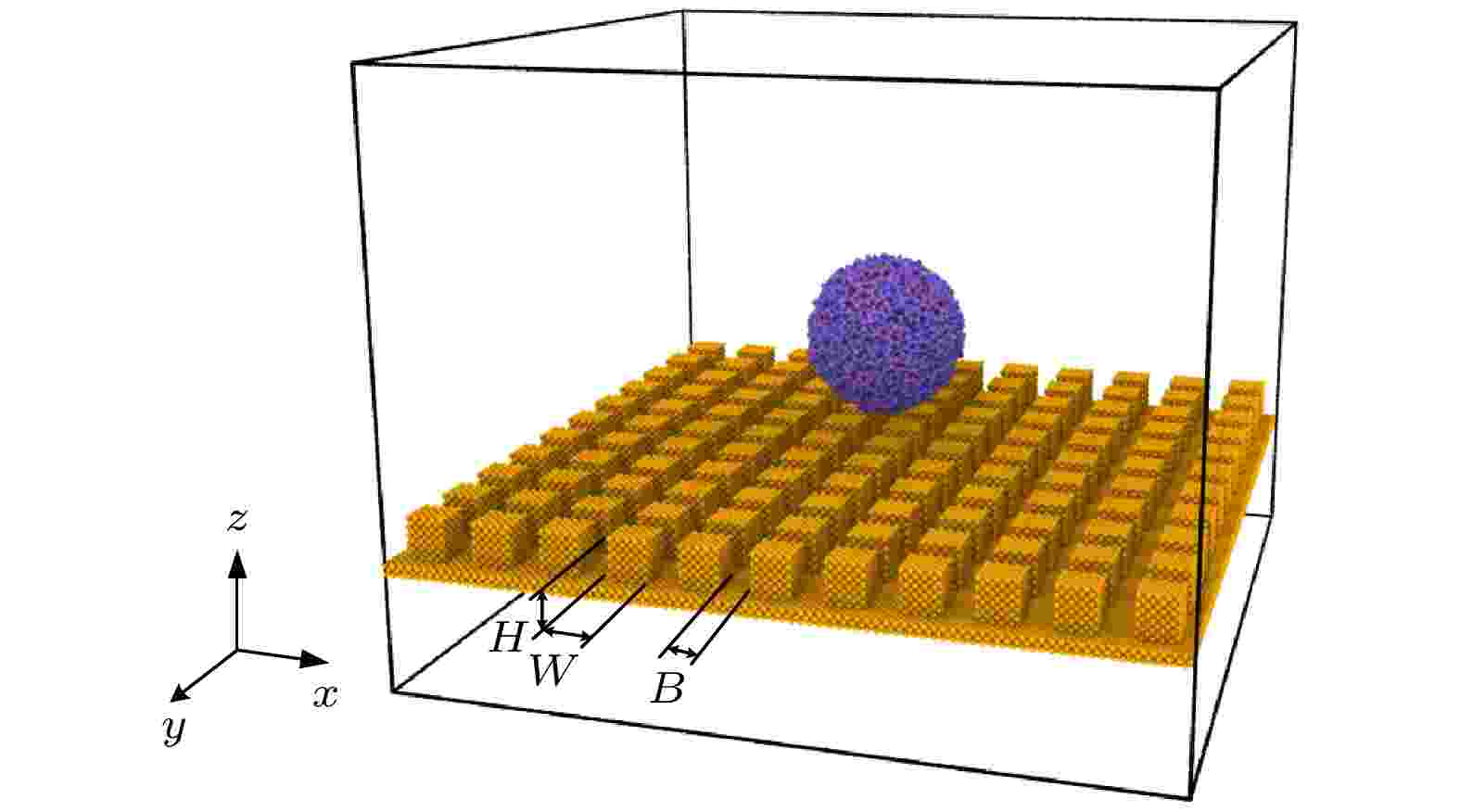 图 1 模拟体系的初始构型
图 1 模拟体系的初始构型Figure1. Initial configuration of the simulation system.











水和铜之间的LJ相互作用参数






模拟过程中LJ相互作用和库伦相互作用的截断半径分别取为10 ?和12 ?. 采用Velocity-Velet算法求解牛顿运动方程, 积分时间步长为1 fs, 采用PPPM算法(particle-particle particle mesh)计算长程库仑力[32,33].
为使模拟过程更符合物理规律, 确保模拟结果的准确, 首先对非平衡态的初始体系进行能量最小化, 随后对其进行NVT 系综下的弛豫. 弛豫过程选择Nose-Hoover方法进行控温[34,35], 目标温度为298 K. 弛豫过程中, 水分子的速度设置符合Maxwell-Boltzmann分布. 经过足够长时间的弛豫, 模拟体系达到能量稳定状态, 此时模拟区域中有气相水分子存在[36]. 然后, 取消NVT系综, 消除对温度的控制, 对模拟体系施加NVE系综, 同时对液滴施加竖直向下的初始速度V0, 当液滴刚接触固体表面时开始数据收集.
4.1.液滴接触角的计算
接触角是表征固体表面性能的重要参数. 为了计算液滴在光滑铜表面的接触角, 用小立方体对模拟体系进行划分, 立方体的尺寸为1 ? × 1 ? × 1 ?. 由于液滴在x-y平面投影的对称性, 故只分析右半部分. 计算每个立方体内水分子的密度进而获得液滴密度云图, 如图2所示. 选择密度为0.5 g/cm3的等密度线作为液态-气态的分界线[16,30] (图2中黑色曲线). 液滴的形状可假设为圆的一部分, 根据圆的方程(4)式拟合出液滴轮廓, 进而根据(5)式计算接触角θ[30].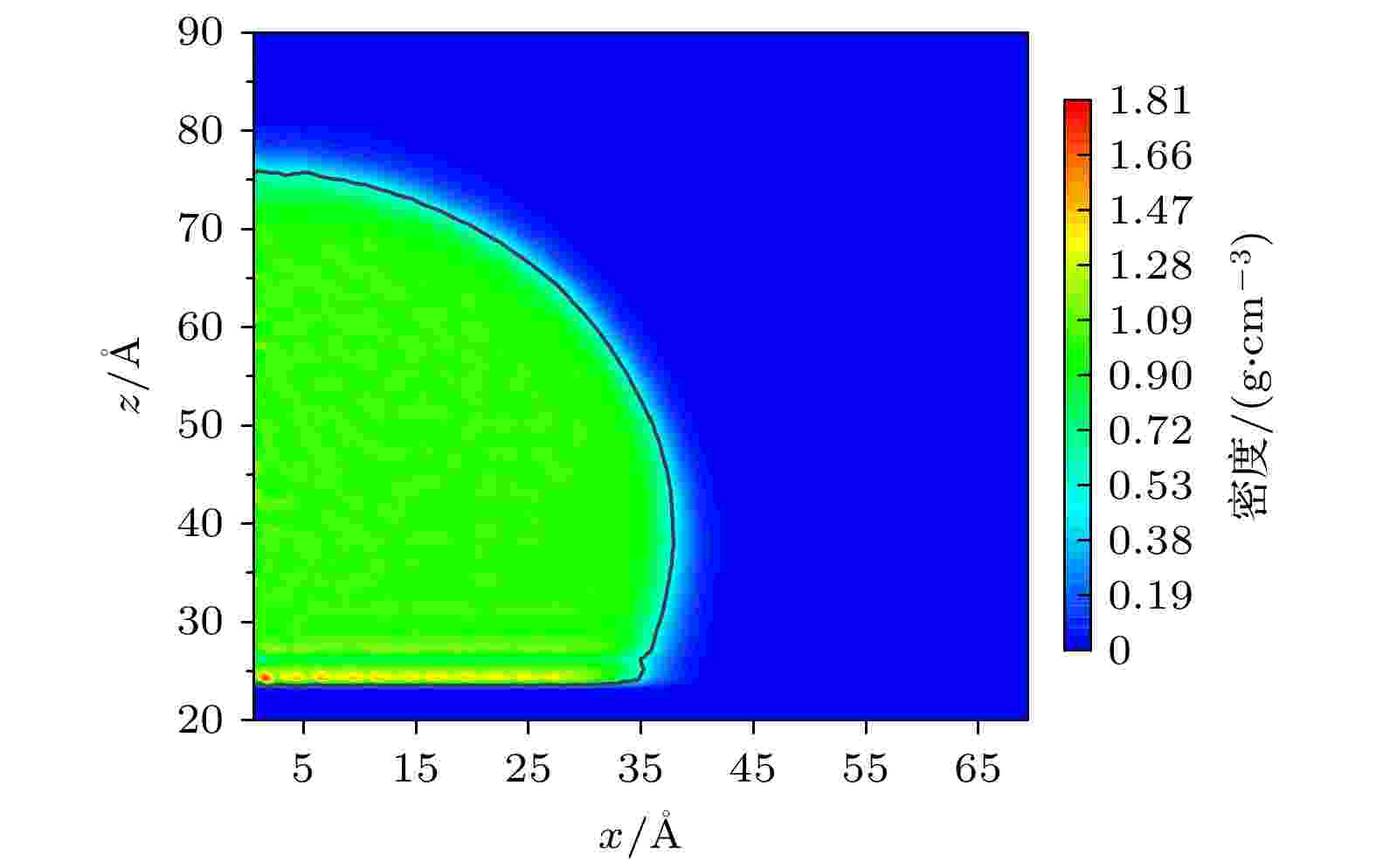 图 2 液滴右半部分密度云图
图 2 液滴右半部分密度云图Figure2. Density profile of the right-sided droplet.
2
4.2.液滴初始半径对动态行为的影响
对半径分别为35, 40, 及45 ?的液滴在光滑表面和柱状固体表面的铺展过程进行分析. 由图3可知, 尽管液滴的半径不同, 但无量纲量R/R0 (R是铺展半径, 即液滴与固体表面接触区域的半径; R0是液滴初始半径)随铺展时间t的变化高度重合, 最大相对误差为6.9%. 为在保证模拟精度的同时提高计算效率, 采用R0 = 35 ?的液滴进行进一步的研究.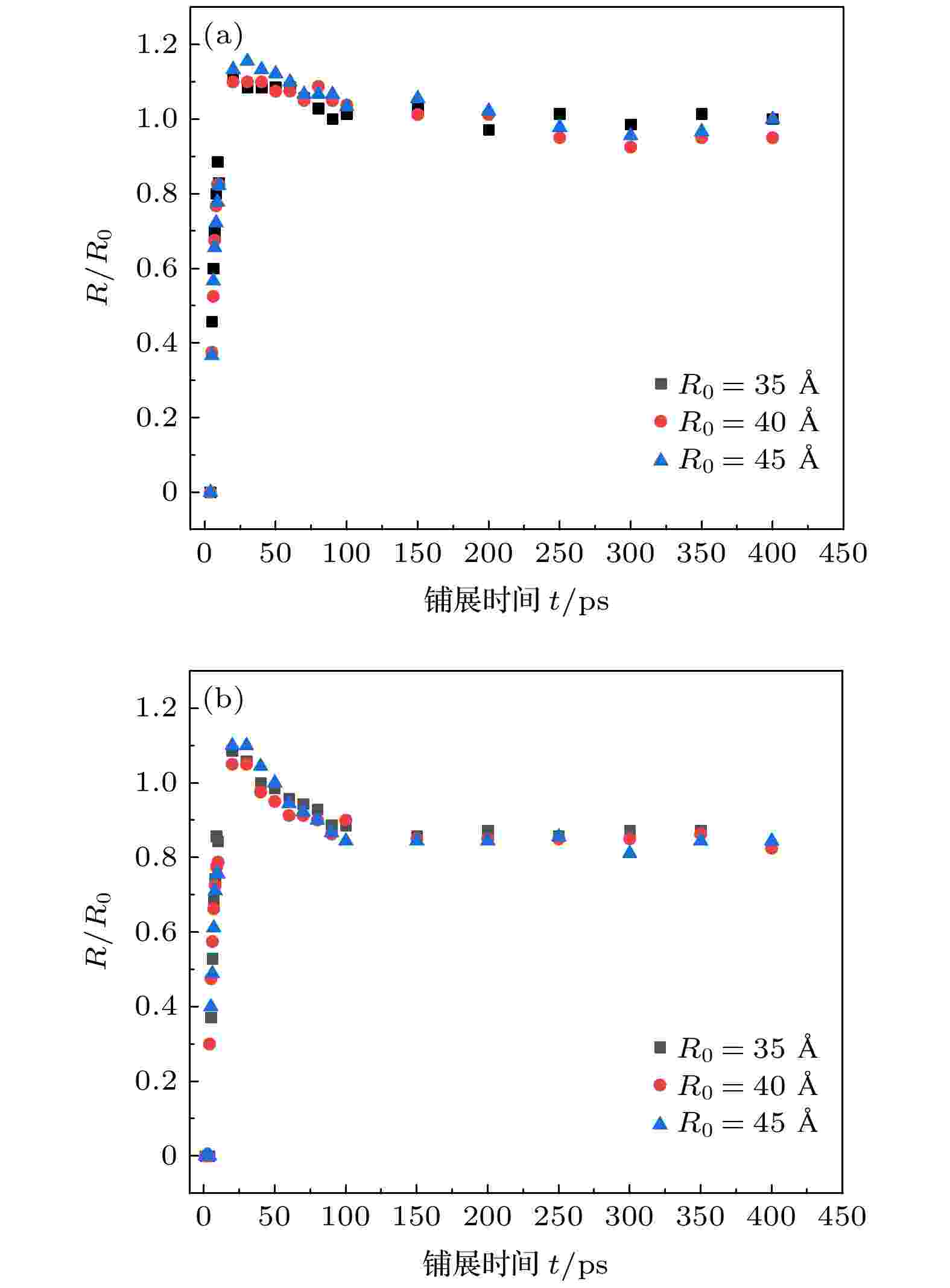 图 3 液滴尺寸对铺展时间t的影响 (a) 液滴在光滑固体表面上; (b) 液滴在柱状固体表面上
图 3 液滴尺寸对铺展时间t的影响 (a) 液滴在光滑固体表面上; (b) 液滴在柱状固体表面上Figure3. Effects of droplets size on spreading time: (a) Droplets on the flat solid surfaces; (b) droplets on the nanopillared solid surfaces.
2
4.3.初始速度的影响
由于尺度差异, 纳米液滴需要更大的初始速度V0才能获得与宏观液滴相似的变形[38], 也只有在高速的情况下, 纳米液滴才能与宏观或试验中的液滴有相同的韦伯数We:

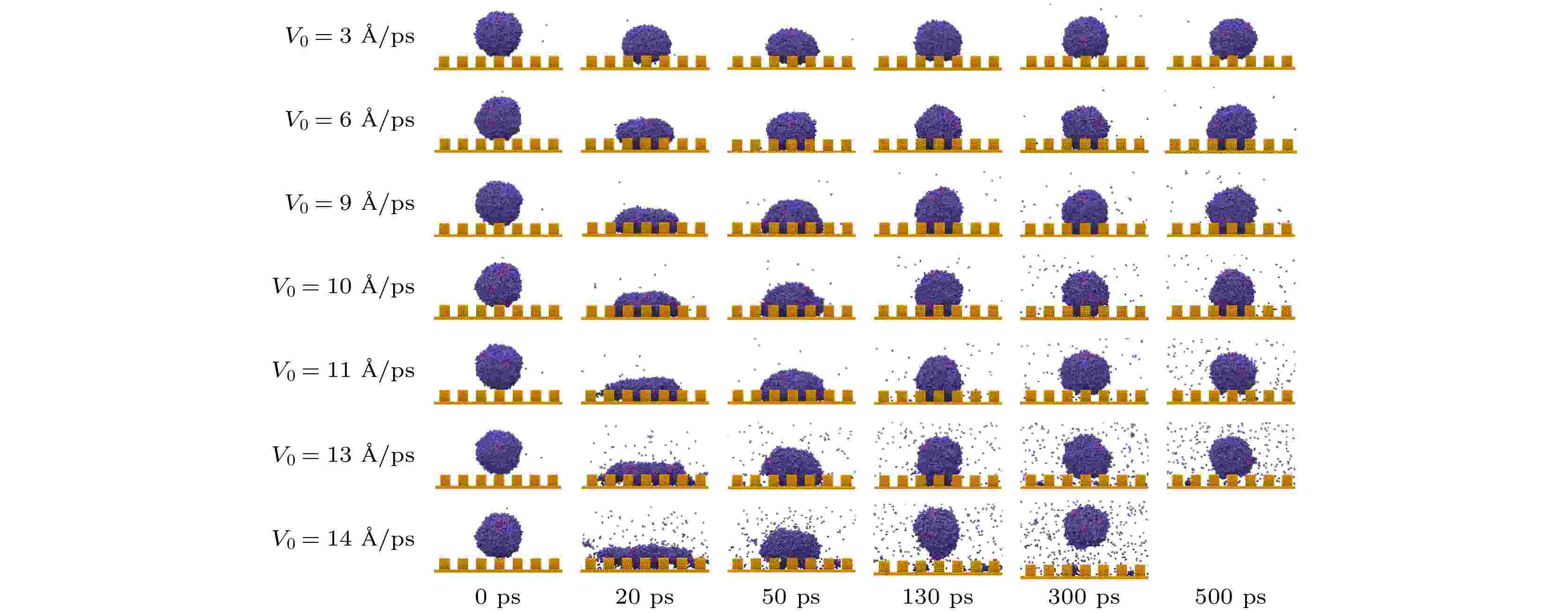 图 4 不同速度的液滴撞击柱状固体表面的动态行为
图 4 不同速度的液滴撞击柱状固体表面的动态行为Figure4. Dynamic behaviors of droplets with various velocities impinging on nanopillared solid surfaces.
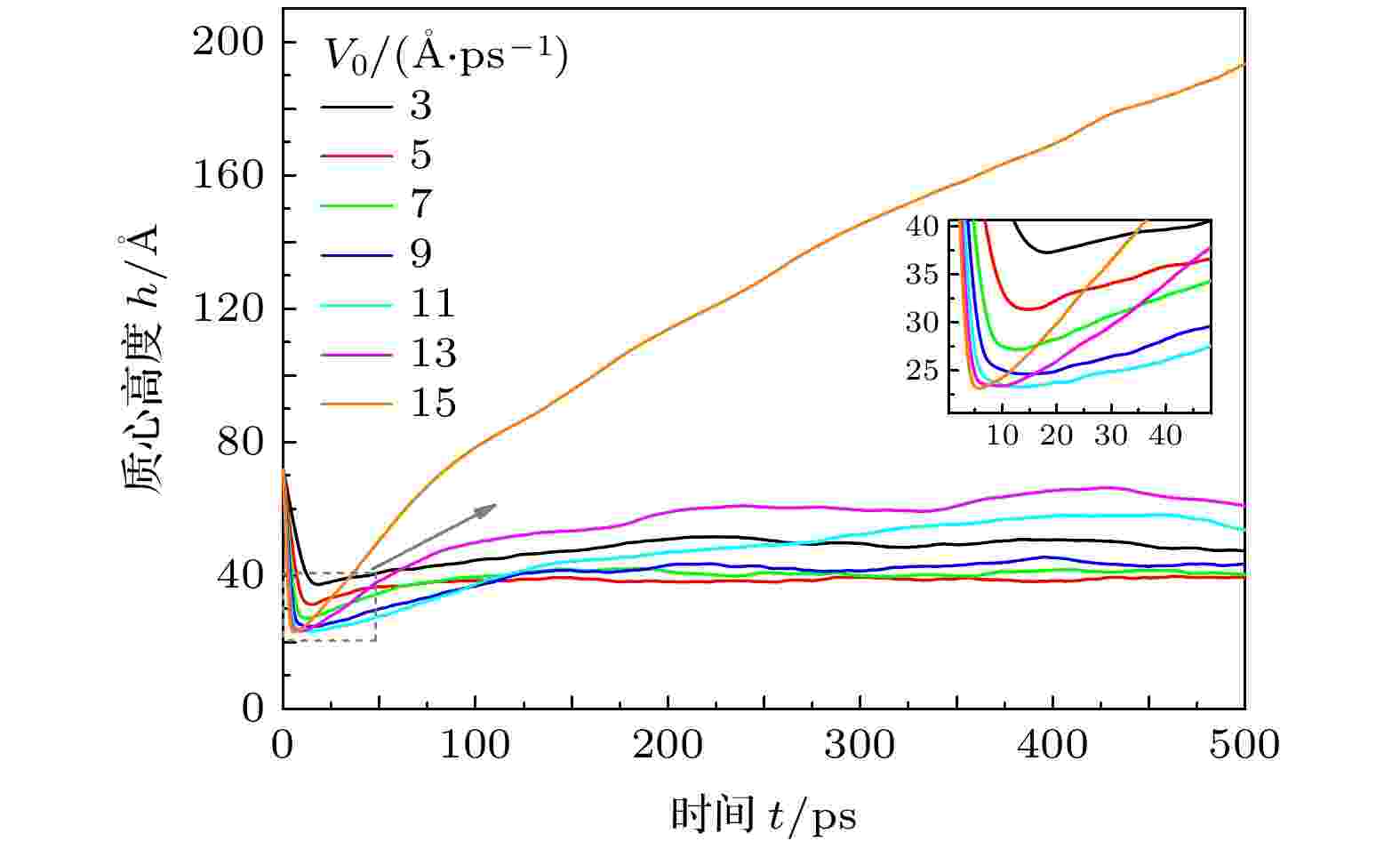 图 5 液滴质心高度h随铺展时间t的变化
图 5 液滴质心高度h随铺展时间t的变化Figure5. Time evolution of central height of droplets with different velocities.
| V0/(?·ps–1) | 2—3 | 4—10 | 11—13 | 14—15 |
| 润湿模式 | Cassie | Wenzel | Cassie | 弹跳 |
表1液滴撞击柱状固体表面稳定状态时的润湿模式
Table1.Wetting patterns of steady state of droplets impinging on nanopillared solid surfaces.
当V0 = 3 ?/ps时, 液滴具有的动能较小, 铺展过程中很快被消耗完, 在表面张力的作用下, 变形的液滴开始回缩, 液滴最终呈现Cassie态. 随着V0增加至5—9 ?/ps, 具有更高动能的液滴促使铺展区域进一步扩展. 在回缩阶段, 由于液滴完全充满柱间空隙并接触固体表面底层, 固液间相互作用增强, 液滴的表面能不足以克服该相互作用, 液滴最终呈现Wenzel态. 当V0进一步增大至11—13 ?/ps, 回缩阶段液滴的表面能虽然可以克服前述两者的吸引, 但未能克服柱状结构上表面对液滴的吸引, 从而近似球状地停留在固体表面上呈现Cassie态. 当V0继续增加至14 ?/ps时, 液滴在130 ps时被拉伸产生显著变形, 最终完全挣脱固体表面的吸引发生弹跳. 液滴发生弹跳的临界速度为13 ?/ps. 需要指出, 尽管在V0较大时, 有部分水分子脱离液滴主体, 以V0 = 14 ?/ps为例对液滴前后尺寸进行计算, 液滴尺寸仅有4%的改变, 即脱离液滴主体的水分子由于占比很小, 其对液滴动态过程研究的影响可以忽略.
液滴质心高度h的变化如图5所示, 质心高度最小值hmin随着液滴初始速度V0的增大而逐渐降低. 这是因为液滴速度的增大使其具有更大的动能进行铺展, 增大了液滴铺展面积, hmin随之减小.
图6为液滴最大铺展时间tmax随V0的变化. tmax定义为液滴从接触固体表面至达到最大铺展状态所需时间. 根据变化规律不同, 将其按V0大小分为低速区(0—6 ?/ps)、中速区(6—9 ?/ps)和高速区(9—15 ?/ps). tmax与V0的关系如下式所示:
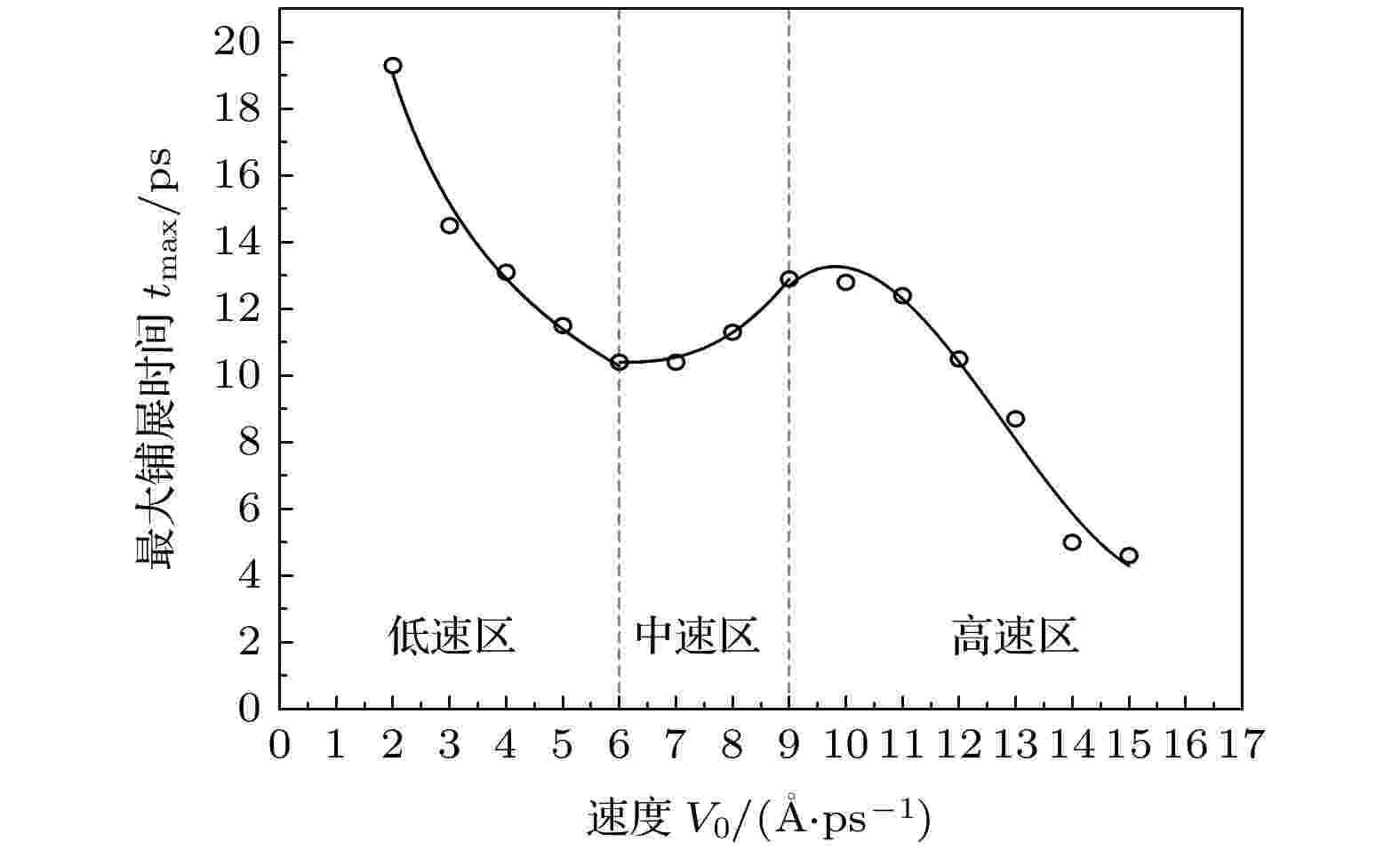 图 6 最大铺展时间tmax随速度V0的变化
图 6 最大铺展时间tmax随速度V0的变化Figure6. The dependence of the maximum spreading time of droplets on velocities.
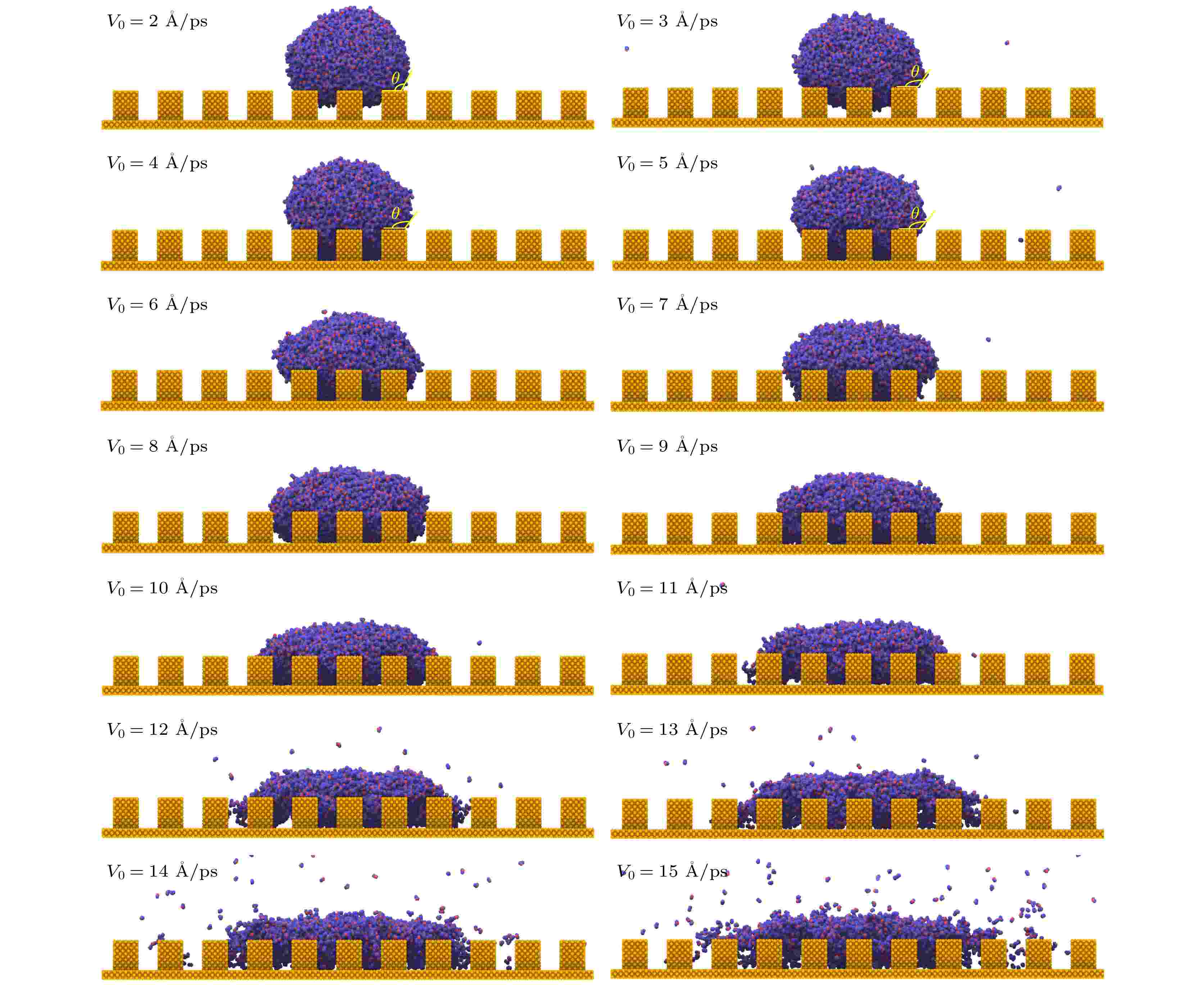 图 7 不同速度液滴的最大铺展状态
图 7 不同速度液滴的最大铺展状态Figure7. The maximum spreading states of droplets with different velocities.
V0处于6—9 ?/ps中速区的液滴, 由于动能的增加, 液滴得以克服钉扎效应带来的铺展阻碍. 液滴开始进入并向更多的方柱间隙铺展. 由于克服钉扎效应消耗了液滴的动能, 导致液滴继续铺展的速度降低.V0较小的液滴其动能很快被消耗尽, 而V0较大的液滴有着相对高的动能, 其动能的耗尽需要更多的时间, 也即增加了液滴达到最大铺展状态所需时间tmax.
当V0达到9—15 ?/ps的高速区时, 液滴开始向更多的方柱顶铺展. 虽然铺展过程中同样受到钉扎效应的阻碍, 但液滴有着足够高的动能可以将之克服. 因此tmax仍呈现下降趋势.
为定量描述液滴的动态铺展, 定义铺展半径R与初始半径R0的比值为铺展因子β. 图8是不同V0的液滴其β随时间t的变化. 由图8可见, 随着V0的增加最大铺展因子βmax逐渐增大, 当V0增大到15 ?/ps时, βmax = 1.757. 当V0 < 9 ?/ps时, 液滴稳定态的β基本相等. 当V0 > 9 ?/ps时, 液滴稳定态的β逐渐减小, 直到V0增至14 ?/ps时, 弹跳离开固体表面, 此时β = 0.
 图 8 不同初始速度的液滴铺展因子β随时间t的变化 (a) V0 = 3—9 ?/ps; (b) V0 = 11—15 ?/ps
图 8 不同初始速度的液滴铺展因子β随时间t的变化 (a) V0 = 3—9 ?/ps; (b) V0 = 11—15 ?/psFigure8. Time evolution of spreading factor for droplets with different velocities: (a) V0 = 3?9 ?/ps; (b) V0 = 11?15 ?/ps.
图9为不同V0的液滴对应的最大铺展因子βmax, 两者近似线性关系, 拟合得到该线性方程为
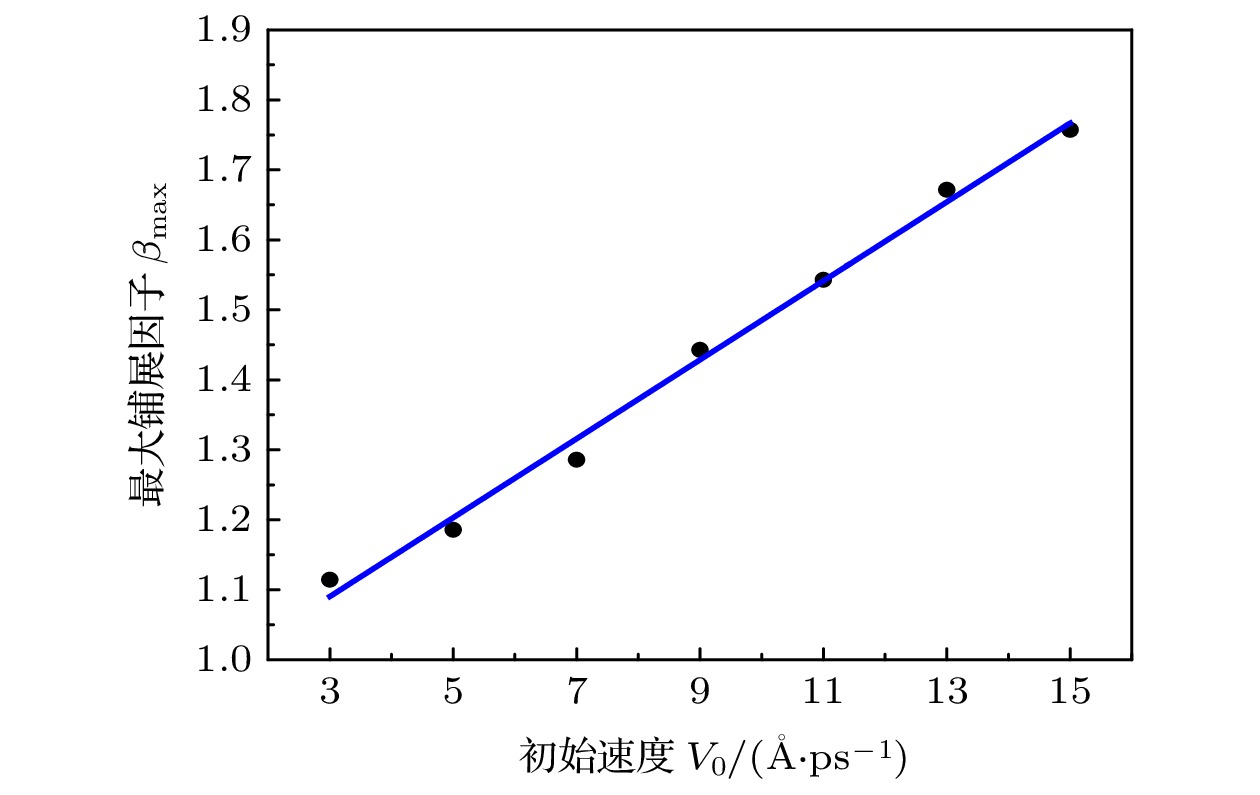 图 9 不同初始速度液滴的最大铺展因子βmax
图 9 不同初始速度液滴的最大铺展因子βmaxFigure9. The maximum spreading factor of droplets with different velocities.
2
4.4.方柱高度的影响
选定V0为3 ?/ps的液滴, 改变方柱高度H, 探究其对液滴动态行为的影响. 设置方柱高度分别H1 = 10.845 ?, H2 = 14.460 ?, H3 = 18.075 ?, H4 = 21.690 ?和H5 = 25.305 ?. 图10和表2展示了液滴撞击后的稳定状态及润湿模式. 当方柱高度为H1和H2时, 液滴完全充满方柱间隙, 呈现Wenzel态; 当方柱高度为H3, H4和H5时, 液滴渗入方柱间隙的深度随着高度的增加而减小. 图 10 液滴撞击不同方柱高度固体表面的稳定状态
图 10 液滴撞击不同方柱高度固体表面的稳定状态Figure10. Steady states of droplets impinging on solid surfaces with nanopillars of different height.
| 方柱 高度 | H1 | H2 | H3 | H4 | H5 |
| 10.845 ? | 14.460 ? | 18.075 ? | 21.690 ? | 25.305 ? | |
| 润湿 模式 | Wenzel | Wenzel | Cassie | Cassie | Cassie |
表2液滴撞击不同高度柱状表面后的稳定态润湿模式
Table2.Wetting patterns of steady state of droplets impinging on surfaces with different height nanopillars.
图11记录了方柱高度为H5时, 不同时刻液滴底部的z向坐标. 在模拟过程中zmin = 20 ?. 据此, 可得到液滴渗入方柱间隙最大深度为8.920 ?, 与固体表面底层最大距离为16.385 ?, 大于LJ势的截断半径10 ?, 因此可以认为方柱高度为H5的固体表面, 液滴的动态行为不受固体表面底层影响. 对方柱高度为H1, H2, H3和H4的表面, 假设液滴不受固体表面底层影响, 其在动态过程中与固体表面底层最大距离分别为: 1.925 ?, 5.540 ?, 9.155 ?和12.770 ?. 可见当方柱高度为H1和H2时, 液滴能够完全充满方柱间隙处于Wenzel态, 是因为液滴与固体表面底层的距离过近, 明显小于LJ势的截断半径, 此时固液间有着非常大的吸引力.
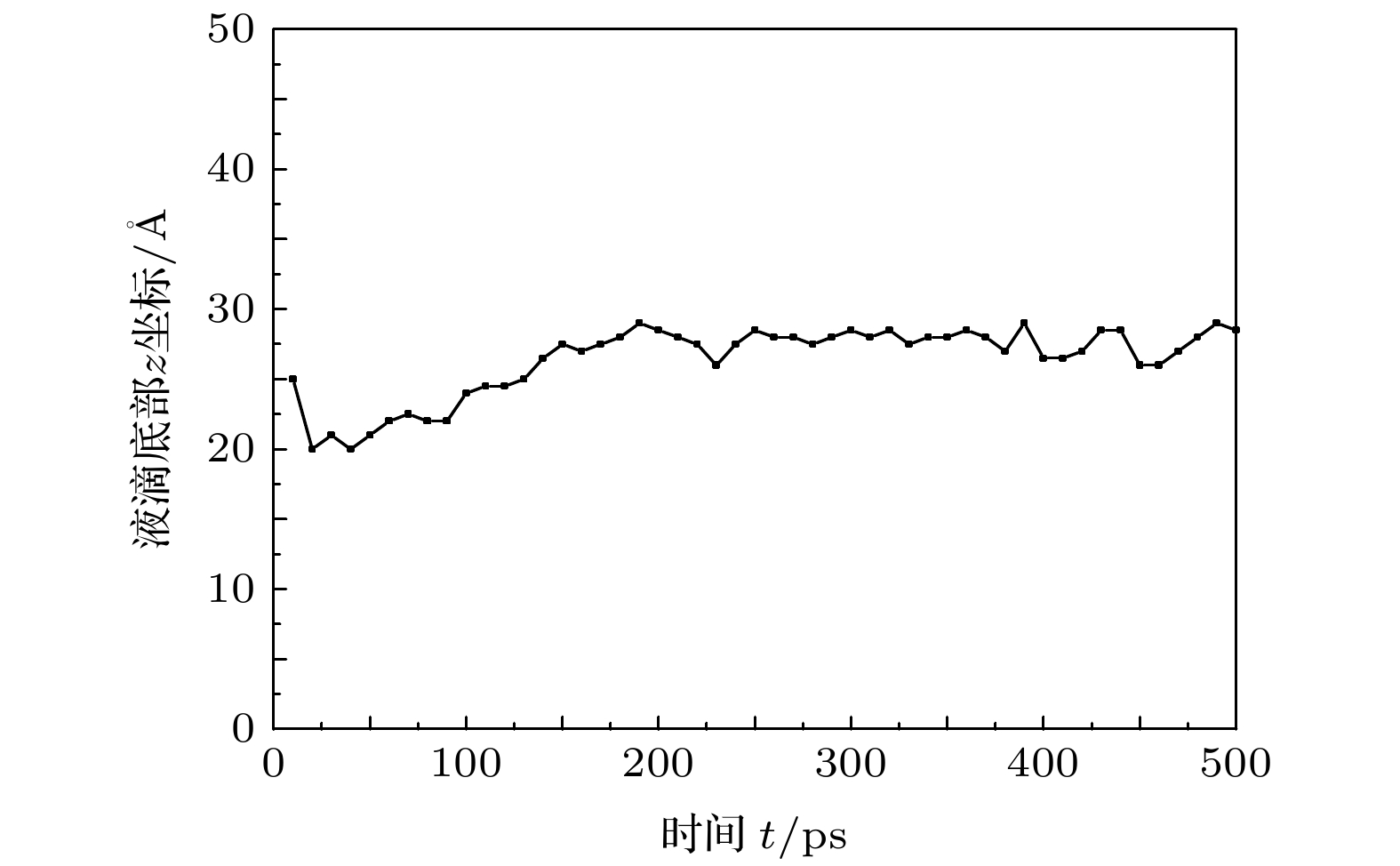 图 11 不同时刻液滴底部z坐标
图 11 不同时刻液滴底部z坐标Figure11. Time evolution of z coordinates for the bottom of droplets.
图12展示了液滴撞击不同高度柱状固体表面时质心高度h的变化. 对于H1和H2, h在经历前期的下降后几乎保持水平且两者基本重合. 表明当液滴能够完全充满方柱间隙时, 方柱高度的变化对h没有影响. 但当方柱高度达到临界值18.075 ?时, 液滴最终呈现Cassie态, h有突然的增加. 当方柱高度H > 18.075 ?时, 对应液滴质心高度的增加量等于方柱高度的增加. 由图13可知, 方柱高度为H4和H5, 液滴达到稳态时β约为0.800, 小于其他三种情况, 表明随着H的增加, 液滴的铺展能力减小. 方柱高度的变化对βmax几乎没有影响且液滴在达到最大铺展状态前β基本一致. 因此, 方柱高度对铺展过程的影响主要作用在液滴的回缩阶段.
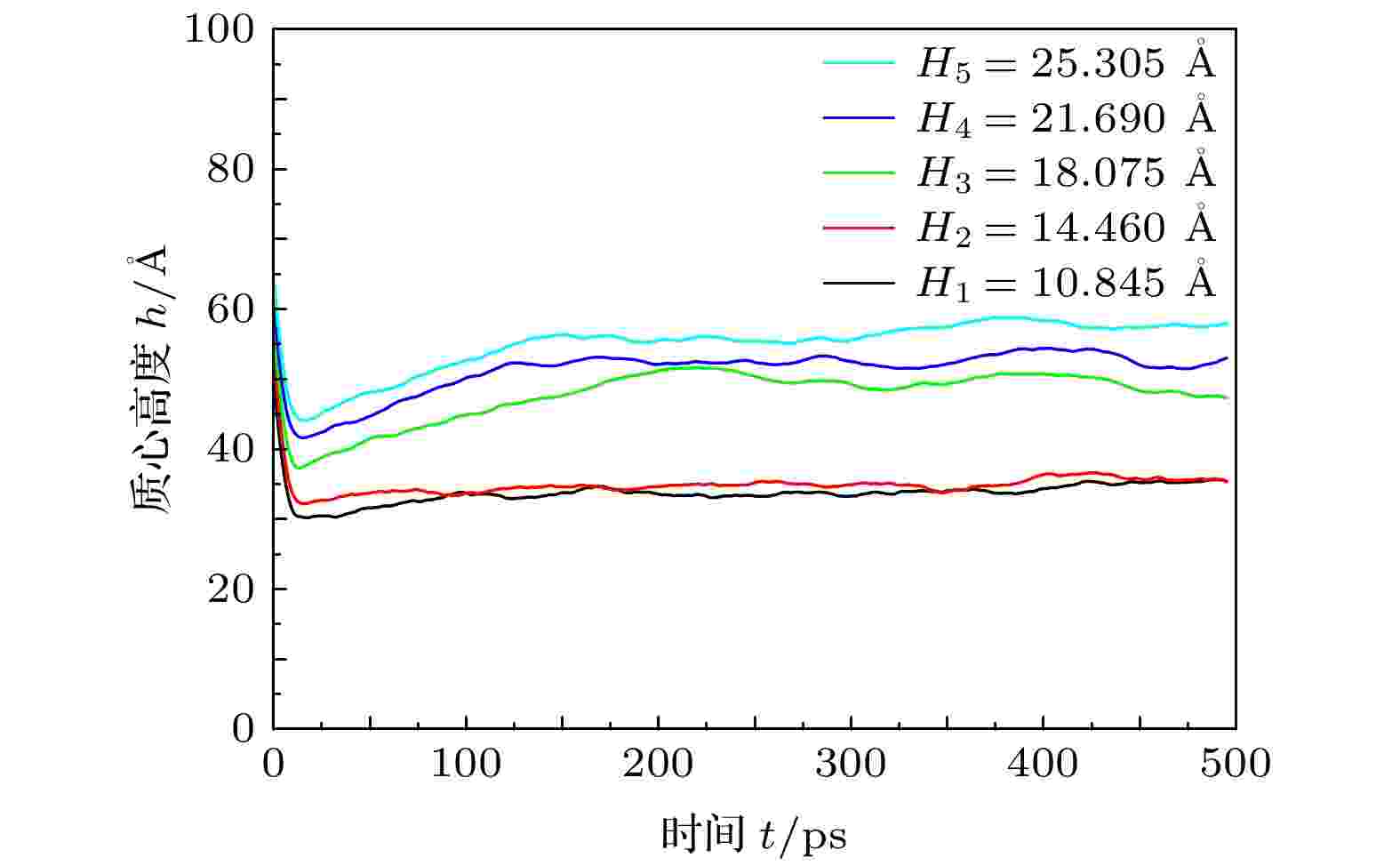 图 12 不同方柱高度对液滴质心高度的影响
图 12 不同方柱高度对液滴质心高度的影响Figure12. Effects of nanopillars with different height on centroid height of droplets.
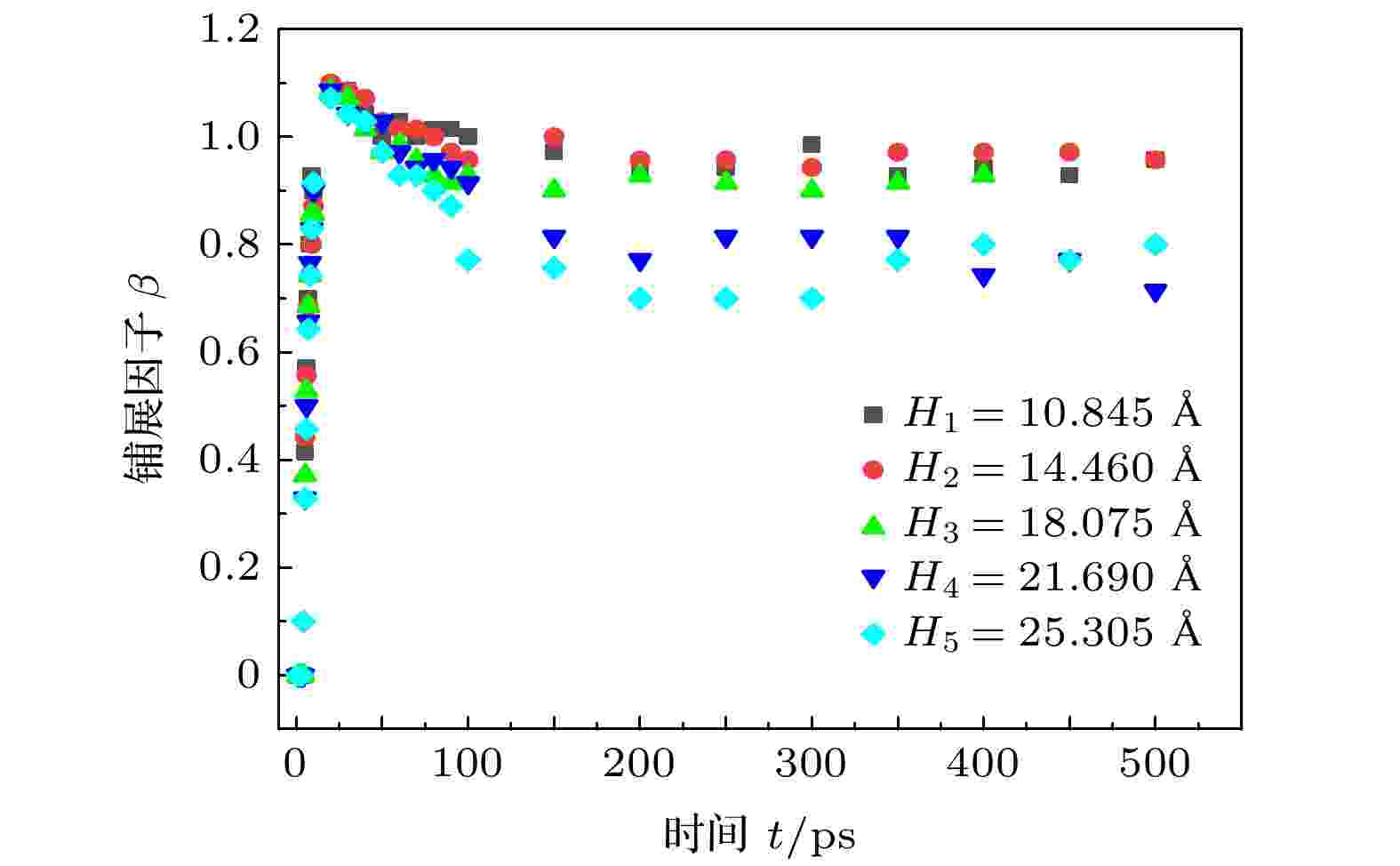 图 13 方柱高度对铺展因子的影响
图 13 方柱高度对铺展因子的影响Figure13. Dependence of spreading factor on the height of nanopillars.
图14展示了不同高度的方柱对液滴稳定状态下铺展半径R的影响. 随着H的增加, 液滴稳定时R逐渐下降且下降程度逐渐减小, 表明H虽然对液滴的铺展过程有影响, 但影响逐渐减弱.
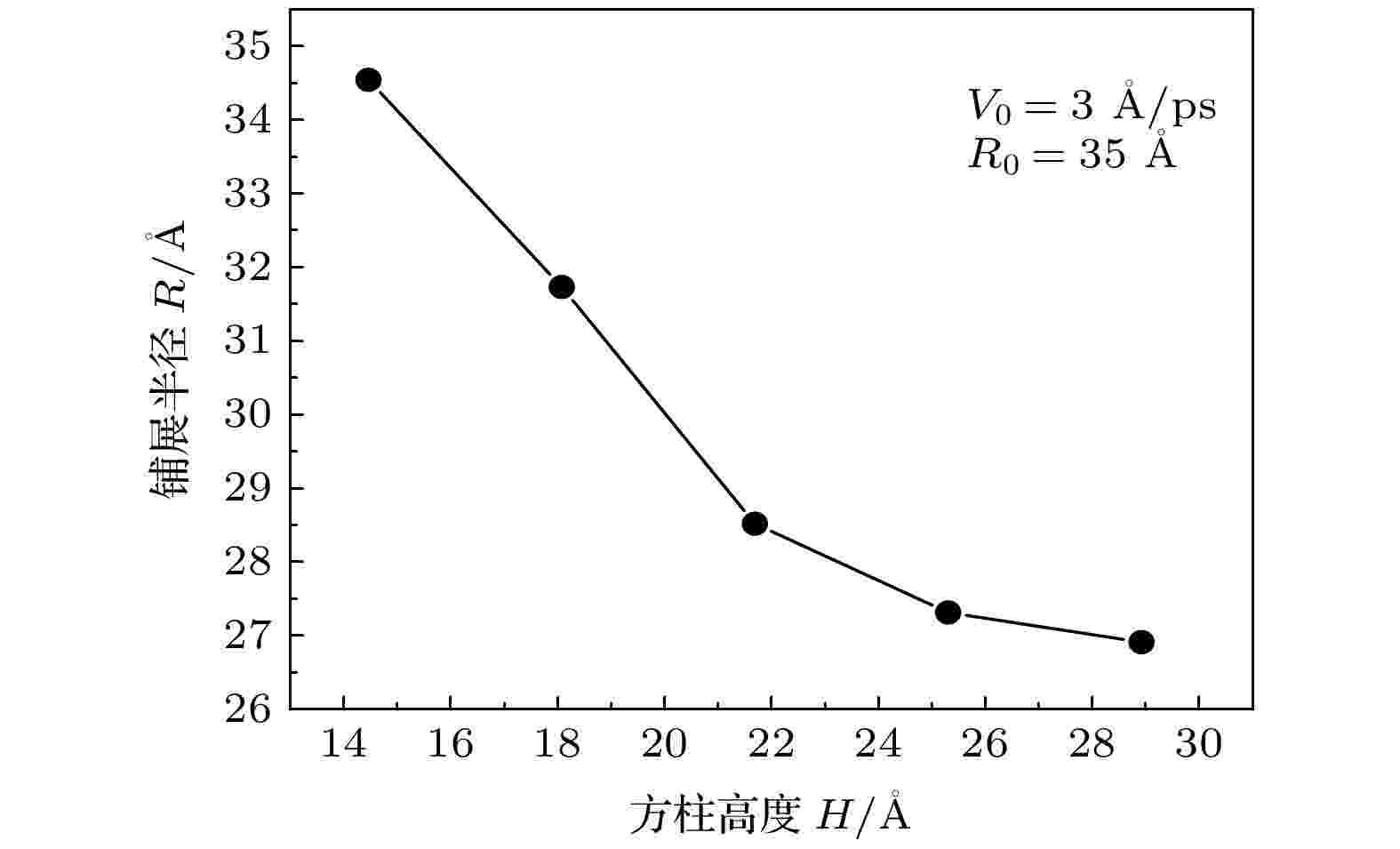 图 14 方柱高度对铺展半径R的影响
图 14 方柱高度对铺展半径R的影响Figure14. Dependence of spreading radius on the height of nanopillars.
2
4.5.固体表面特征能的影响
固体的表面特征能





| ${\varepsilon _{\rm{s}}}$/(kcal·mol–1) | ${\varepsilon _{\rm{s}}}$/(kcal·mol–1) | 接触角$ \theta $/$ (°) $ |
| ${\varepsilon _{{\rm{s1}}}} = 0.5{\varepsilon _{{\rm{Cu}}}} = 0.119$ | 0.139 | 125.9 |
| ${\varepsilon _{{\rm{s2}}}} = 1.5{\varepsilon _{{\rm{Cu}}}} = 0.357$ | 0.241 | 97.1 |
| ${\varepsilon _{{\rm{s3}}}} = 2.0{\varepsilon _{{\rm{Cu}}}} = 0.476$ | 0.278 | 80 |
| ${\varepsilon _{{\rm{s4}}}} = 3.0{\varepsilon _{{\rm{Cu}}}} = 0.714$ | 0.341 | 63 |
| ${\varepsilon _{{\rm{s5}}}} = 4.0{\varepsilon _{{\rm{Cu}}}} = 0.952$ | 0.394 | 45 |
| ${\varepsilon _{{\rm{s6}}}} = 5.0{\varepsilon _{{\rm{Cu}}}} = 1.190$ | 0.440 | 22 |
表3不同



Table3.Corresponding


由表3可知: 随着































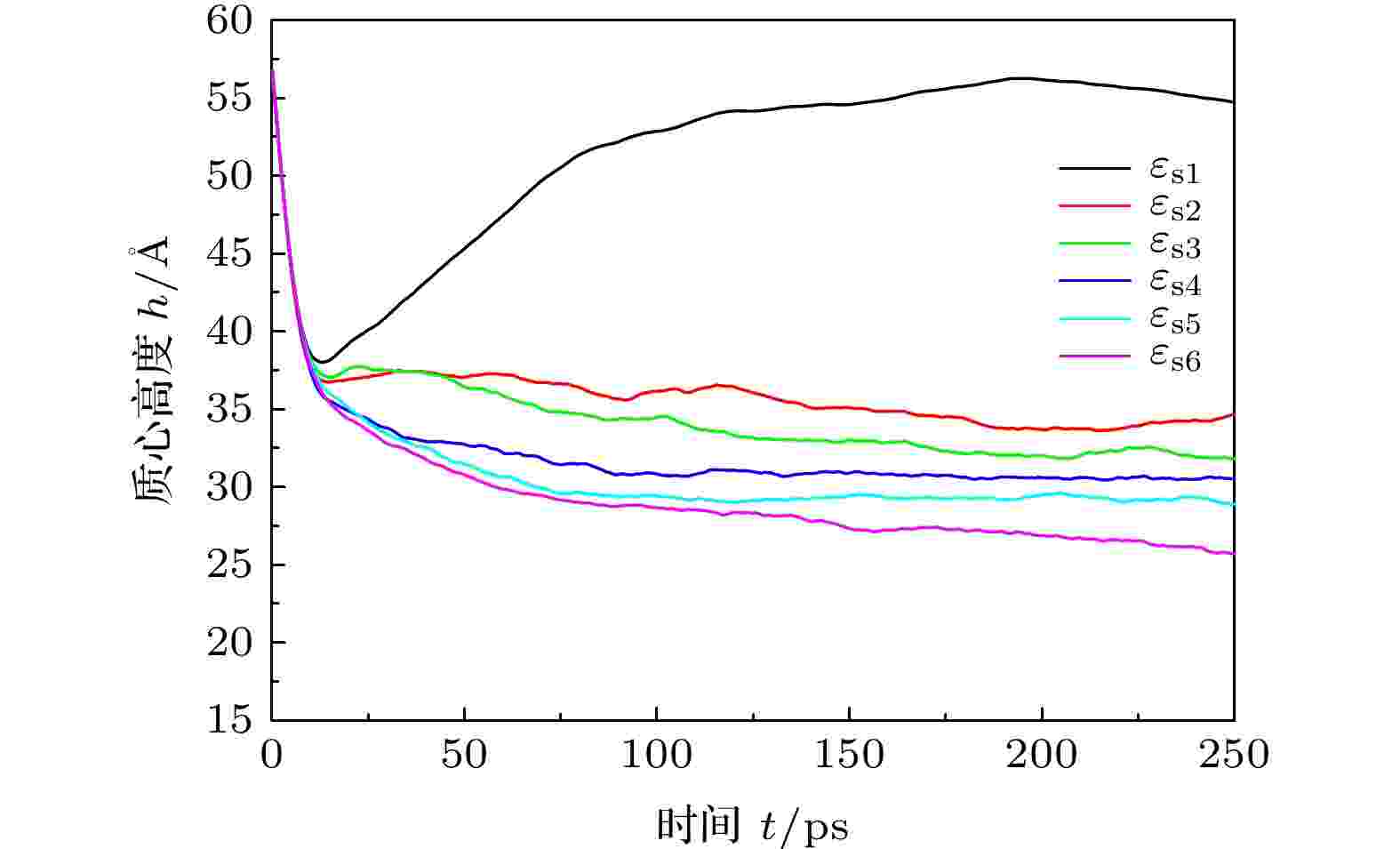 图 15 液滴撞击不同特征能柱状固体表面的质心高度
图 15 液滴撞击不同特征能柱状固体表面的质心高度Figure15. Centroid height of droplets impinging on surfaces with different characteristic energy.
图16展示了铺展因子β的变化. 当


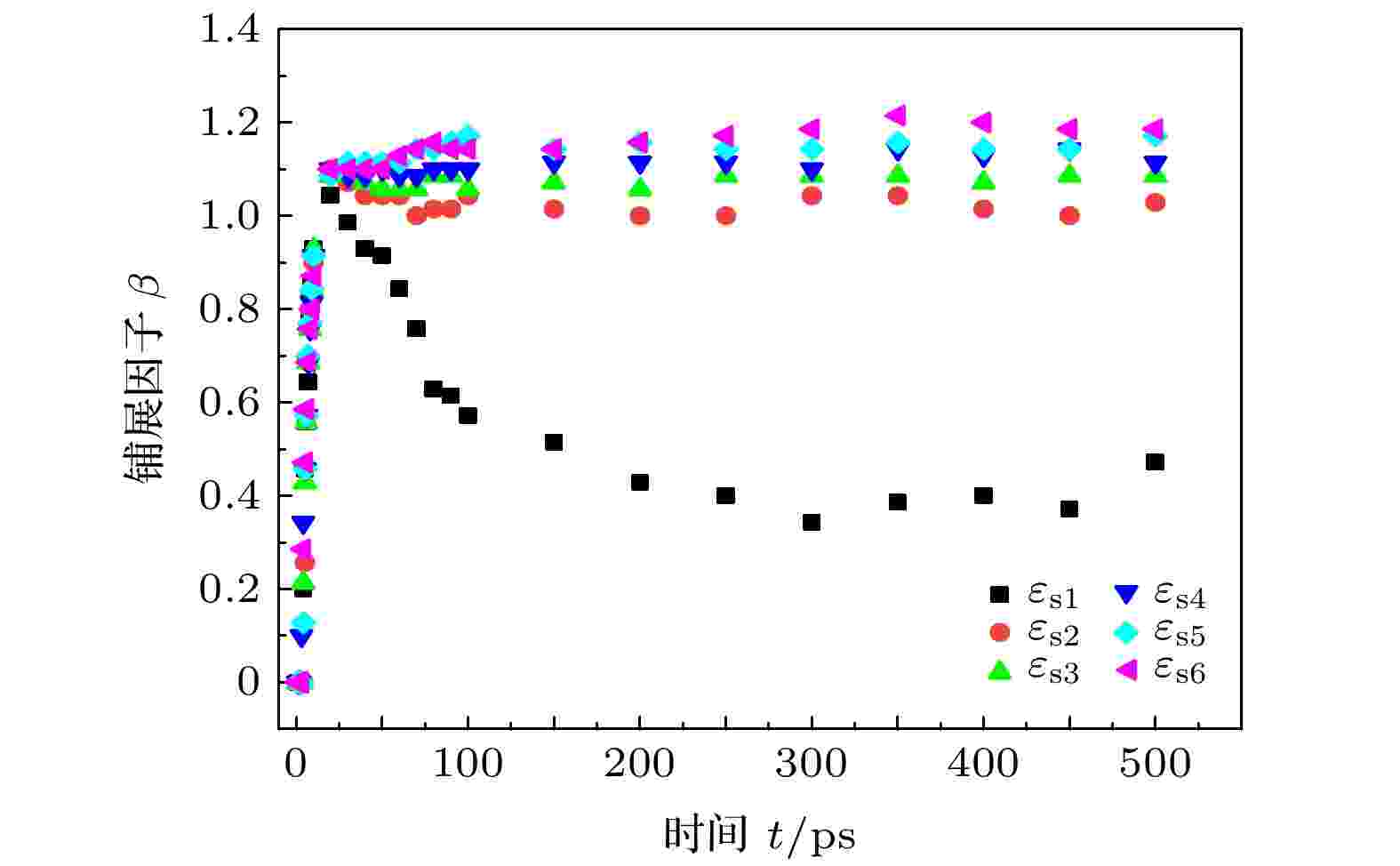 图 16 液滴撞击具有不同特征能方柱表面时的铺展因子
图 16 液滴撞击具有不同特征能方柱表面时的铺展因子Figure16. Time evolution of spreading factor of droplets impinging on surfaces with different characteristic energy.
不同于质心高度随








1) 随着液滴撞击的初始速度增加, 液滴的稳定状态先由Cassie态转变为Wenzel态, 然后再次呈现Cassie态, 并得到液滴发生弹跳离开固体表面的临界初始速度V0 = 13 ?/ps;
2) 首次发现液滴最大铺展时间tmax与初始速度V0关系曲线中拐点的存在, 并提出不同速度区域中tmax与V0的关系式;
3) 方柱高度对液滴动态过程的影响主要在液滴的回缩阶段, 但随着方柱高度的进一步增加影响逐渐减小, 方柱高度的增加有助于液滴的稳定态由Wenzel向Cassie态转变;
4) 表面特征能




